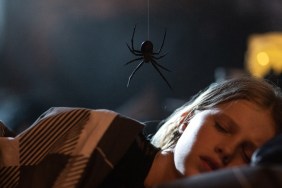
Mike Leigh and cinematographer Dick Pope (The Illusionist) have turned the big screen into their canvas, painting a picture of the life of British painter J.M.W. Turner (played to the hilt and full of phlegm by Timothy Spall) in a film that’s beautiful to look at and yet a bit of slog to endure. Mr. Turner is a Mike Leigh film through and through, presenting the life of his protagonist at face value, flaws and all, but I found it difficult to render any connection to the material.
At two and a half hours I need to feel as if there is some reason I’m watching beyond bearing witness to two masters (Pope and Leigh) using Turner’s life’s work as inspiration for a beautiful film to look at, yet dull to spend too much time with. This felt more like a series of well-made home videos someone felt I would find interesting, but as someone that’s not an art major or a Turner enthusiast, there was very little I found intriging.
Timothy Spall certainly gives himself over to the role and it’s not an attractive role to begin with. Turner grunts as much as he uses his words. As his character ages, the sound of phlegm caught in his throat is exaggerated, making him hard to listen to, and the makeup on his face and teeth makes him almost impossible to look at. In a lot of ways, it’s almost too much and this isn’t to say I need my cinematic aging to be depicted as pretty occurrences, but in a movie where I found so little of interest, watching a man turn into a hacking goblin borders on grotesque.
The first third of Mr. Turner holds a mild level of curiosity. We’re introduced to his housekeeper (Dorothy Atkinson), who clearly holds a high level of love for the man and yet he can only seem to treat her as an object in the room, occasionally taking advantage of her sexually. Leigh is sure to show she is also increasingly being consumed by leprosy, which is really how most everything else in the film is presented, taking a matter-of-fact approach to most anything rather than resorting to exaggeration. I appreciate it and it’s what I love about most all of Leigh’s work, but here I felt it needed a jolt of exaggeration beyond Spall’s performance.
We also meet Turner’s father, William Turner (Paul Jesson), who serves as Turner’s assistant of sorts, living with him for the last 30 years of his life or so, exhibiting his paintings to potential buyers and buying his supplies. Jesson gives the film a jolt of life, something eventually lost once William Turner passes away, a not-so-ironic fact that has an effect both on the film and on Turner’s life.
On a romantic level, Turner bore children with Sarah Danby (played with verve by Ruth Sheen), though that relationship is definitely tainted as Turner doesn’t even admit publicly to having any children. And following the passing of his father he eventually forms a close bond with a landlady in Chelsea by the name of Sophia Booth (Marion Bailey). Booth is a loving woman and a warm smile in the rather ugly nature of Turner’s final days. I almost came to welcome her time on screen if only so the film would stop wallowing in Turner’s decaying condition.
Combating the changes in art, his love-hate relationship with his admirers, peers and public, Leigh uses Turner’s life as a conduit into the exploring the time in which the film is set as much as he does in telling Turner’s story. As such it turns into something of a History Channel segment, touching upon the fringes of the art world during the mid-1800s and one of the era’s great artists, but not so much that I felt it had enough reason for the story to be told.
Where the film excels is in the cinematography. We’ve all seen paintings where the sun is captured head-on, glowing like a blurry ball in the yellow sky, illuminating a beautiful landscape. It’s an image most frequently seen in paintings, but almost never in cinema. Leigh and Pope, however, have managed to replicate it with absolute splendor to the point the camera is staring into the sun and we don’t have to divert our eyes. The imagery is absolutely gorgeous as Pope is quite literally painting with light to the point I began to question how much (if any) was computer generated. I’d be disappointed if I was to learn any of it was digitally altered, but knowing Leigh’s style I don’t expect that to be the case.
The film’s production design is also to be lauded, delivering a “lived in” and authentic quality. Everything feels “of the time” and as extensions of the characters and the world they inhabit.
Finally, the performances are wonderful as Leigh again relies on a series of actors he’s worked with in the past, many from Vera Drake and All or Nothing. I do, however, feel Spall’s performance, while exceptional, borders on excessive. Atkinson’s performance as Turner’s meek housekeeper also came across as a bit too timid. Both of these performances felt, at times, like you could see the acting taking place, especially when compared to someone like Bailey whose work as Mrs. Booth is the best the film has to offer.
Leigh is one of the best filmmakers working today and Mr. Turner is right up there with Topsy-Turvy as one of his biggest undertakings ever in terms of size. However, this film lacks the narrative of Topsy-Turvy, relying more on cinematic atmosphere than actual narrative. Sometimes such an approach can result in great things, but here I felt something was still missing. It might be my lack of knowledge when it comes to art history, but as much as I can sit back and appreciate the craft, I was left underwhelmed by the movie as a whole.









